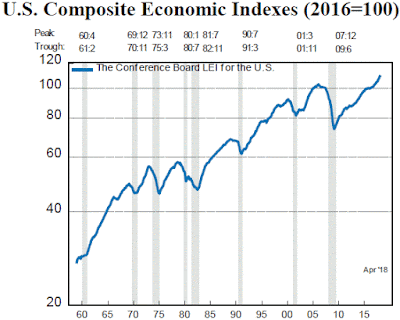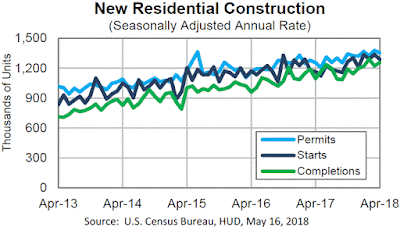Pending Home Sales Index for April 2018
- Actual: 106.4
Previous Month (revised): 107.8
- Change from Previous Month: -1.299% (-1.4 points)
- Change from One Year Previous: -2.116% (-2.3 points)
========
- An index above 100 coincides with a historically high level of home sales activity.
- An index of 100 is equal to the average level of contract activity during 2001, the first year to be analyzed. Coincidentally, 2001 was the first of four consecutive record years for existing-home sales. 2001 sales are fairly close to the higher level of home sales expected in the coming decade relative to the norms experienced in the mid-1990s. As such, an index of 100 coincides with a historically high level of home sales activity.
"...After two straight months of modest increases, pending home sales dipped in April to their third-lowest level over the past year, according to the National Association of Realtors®. All major regions saw no gain in contract activity last month.
The Pending Home Sales Index, www.nar.realtor/pending-home-sales, a forward-looking indicator based on contract signings, declined 1.3 percent to 106.4 in April from an upwardly revised 107.8 in March. With last month’s decrease, the index is down on an annualized basis (2.1 percent) for the fourth straight month.
Lawrence Yun, NAR chief economist, says the housing market this spring is hindered because of the severe housing shortages in much of the country. 'Pending sales slipped in April and continued to stay within the same narrow range with little signs of breaking out,' he said. 'Feedback from Realtors®, as well as the underlying sales data, reveal that the demand for buying a home is very robust. Listings are typically going under contract in under a month, and instances of multiple offers are increasingly common and pushing prices higher.'
Added Yun, 'The unfortunate reality for many home shoppers is that reaching the market will remain challenging if supply stays at these dire levels.'
Heading into the summer months, if low supply and swift price growth were not enough of a headwind for the housing market, Yun believes that rising mortgage rates and gas prices could lead to hesitation among some would-be buyers.
'The combination of paying extra at the pump, while also needing to save more for a down payment because of higher rates and home prices, may weigh on the psyche of those looking to buy,' he said. 'For now, the economy is very healthy, job growth is holding steady and wages are slowly rising. However, it all comes down to overall supply. If more new and existing homes are listed for sale, it would allow home prices to moderate enough to stave off inflationary pressures and higher rates.'
Yun still forecasts for existing-home sales in 2018 to increase 0.5 percent to 5.54 million – up from 5.51 million in 2017. The national median existing-home price is expected to increase around 5.1 percent. In 2017, existing sales increased 1.1 percent and prices rose 5.7 percent.
The PHSI in the Northeast remained at 90.6 in April, and is 2.1 percent below a year ago. In the Midwest the index decreased 3.2 percent to 98.5 in April, and is 5.1 percent lower than April 2017.
Pending home sales in the South declined 1.0 percent to an index of 127.3 in April, but is still 2.7 percent higher than last April. The index in the West inched backward 0.4 percent in April to 94.4, and is 4.6 percent below a year ago.
The National Association of Realtors® is America’s largest trade association, representing 1.3 million members involved in all aspects of the residential and commercial real estate industries.
# # #
According to NAR’s April Realtors® Confidence Index, properties typically stayed on the market for 26 days in April, down from 30 days in March and 29 days a year ago.
The Pending Home Sales Index is a leading indicator for the housing sector, based on pending sales of existing homes. A sale is listed as pending when the contract has been signed but the transaction has not closed, though the sale usually is finalized within one or two months of signing..."
Labels: Economy, existing_home_sales, hard_data, Home Sales, homes, NAR, National_Association_of_Realtors, Pending_Home_Sales, preowned_homes, real_estate, used_homes
|
--> www.FedPrimeRate.com Privacy Policy <--
CLICK HERE to JUMP to the TOP of THIS PAGE > SITEMAP < |














